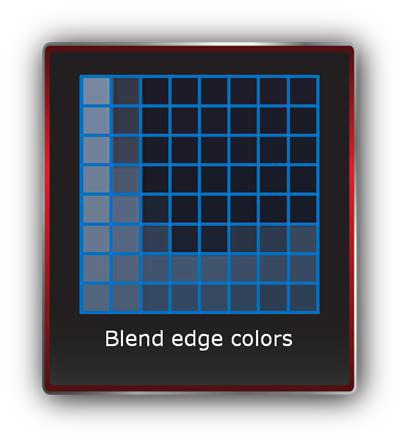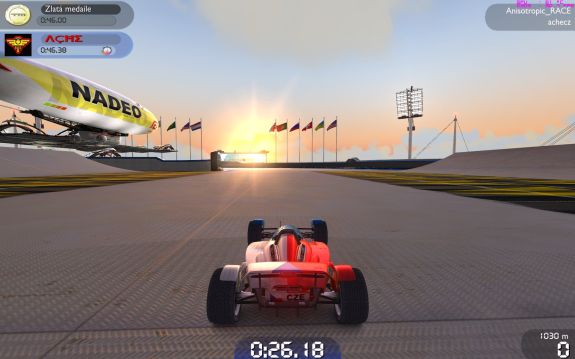AMD’s Radeon HD 6870 & 6850: Renewing Competition in the Mid-Range Market
by Ryan Smith on October 21, 2010 10:08 PM ESTHigh IQ: AMD Fixes Texture Filtering and Adds Morphological AA
“There’s nowhere left to go for quality beyond angle-independent filtering at the moment.”
With the launch of the 5800 series last year, I had high praise for AMD’s anisotropic filtering. AMD brought truly angle-independent filtering to gaming (and are still the only game in town), putting an end to angle-dependent deficiencies and especially AMD’s poor AF on the 4800 series. At both the 5800 series launch and the GTX 480 launch, I’ve said that I’ve been unable to find a meaningful difference or deficiency in AMD’s filtering quality, and NVIDIA was only deficienct by being not quite angle-independent. I have held – and continued to hold until last week – the opinion that there’s no practical difference between the two.
It turns out I was wrong. Whoops.
The same week as when I went down to Los Angeles for AMD’s 6800 series press event, a reader sent me a link to a couple of forum topics discussing AF quality. While I still think most of the differences are superficial, there was one shot comparing AMD and NVIDIA that caught my attention: Trackmania.
The shot clearly shows a transition between mipmaps on the road, something filtering is supposed to resolve. In this case it’s not a superficial difference; it’s very noticeable and very annoying.
AMD appears to agree with everyone else. As it turns out their texture mapping units on the 5000 series really do have an issue with texture filtering, specifically when it comes to “noisy” textures with complex regular patterns. AMD’s texture filtering algorithm was stumbling here and not properly blending the transitions between the mipmaps of these textures, resulting in the kind of visible transitions that we saw in the above Trackmania screenshot.

| Radeon HD 5870 | Radeon HD 6870 | GeForce GTX 480 |
So for the 6800 series, AMD has refined their texture filtering algorithm to better handle this case. Highly regular textures are now filtered properly so that there’s no longer a visible transition between them. As was the case when AMD added angle-independent filtering we can’t test the performance impact of this since we don’t have the ability to enable/disable this new filtering algorithm, but it should be free or close to it. In any case it doesn’t compromise AMD’s existing filtering features, and goes hand-in-hand with their existing angle-independent filtering.
At this point we’re still working on recreating the Trackmania scenario for a proper comparison (which we’ll add to this article when it’s done), but so far it looks good – we aren’t seeing the clear texture transitions that we do on the 5800 series. In an attempt to not make another foolish claim I’m not going to call it perfect, but from our testing we can’t find any clear game examples of where the 6870’s texture filtering is deficient compared to NVIDIA’s – they seem to be equals once again. And even the 5870 with its regular texture problem still does well in everything we’ve tested except Trackmania. As a result I don’t believe this change will be the deciding factor for most people besides the hardcore Trackmania players, but it’s always great to see progress on the texture filtering front.
Moving on from filtering, there’s the matter of anti-aliasing. AMD’s AA advantage from the launch of the 5800 series has evaporated over the last year with the introduction of the GeForce 400 series. With the GTX 480’s first major driver update we saw NVIDIA enable their transparency supersampling mode for DX10 games, on top of their existing ability to use CSAA coverage samples for Alpha To Coverage sampling. The result was that under DX10 NVIDIA has a clear advantage in heavily aliased games such as Crysis and Bad Company 2, where TrSS could smooth out many of the jaggies for a moderate but reasonable performance hit.
For the 6800 series AMD is once again working on their AA quality. While not necessarily a response to NVIDIA’s DX10/DX11 TrSS/SSAA abilities, AMD is introducing a new AA mode, Morphological Anti-Aliasing (MLAA), which should make them competitive with NVIDIA on DX10/DX11 games.
In a nutshell, MLAA is a post-process anti-aliasing filter. Traditional AA modes operate on an image before it’s done rendering and all of the rendering data is thrown away; MSAA for example works on polygon edges, and even TrSS needs to know where alpha covered textures are. MLAA on the other hand is applied to the final image after rendering, with no background knowledge of how it’s rendered. Specifically MLAA is looking for certain types of high-contrast boundaries, and when it finds them it treats them as if they were an aliasing artifact and blends the surrounding pixels to reduce the contrast and remove the aliasing.


MLAA is not a new AA method, but it is the first time we’re seeing it on a PC video card. It’s already in use on video game consoles, where it’s a cheap way to implement AA without requiring the kind of memory bandwidth MSAA requires. In fact it’s an all-around cheap way to perform AA, as it doesn’t require too much computational time either.
For the 6800 series, AMD is implementing MLAA as the ultimate solution to anti-aliasing. Because it’s a post-processing filter, it is API-agonistic, and will work with everything. Deferred rendering? Check. Alpha textures? Done. Screwball games like Bad Company 2 that alias everywhere? Can do! And it should be fast too; AMD says it’s no worse than tier Edge Detect AA mode.
So what’s the catch? The catch is that it’s a post-processing filter; it’s not genuine anti-aliasing as we know it because it’s not operating on the scene as its being rendered. Where traditional AA uses the rendering data to determine exactly what, where, and how to anti-alias things, MLAA is effectively a best-guess at anti-aliasing the final image. Based on what we’ve seen so far we expect that it’s going to try to anti-alias things from time to time that don’t need it, and that the resulting edges won’t be quite as well blended as with MSAA/SSAA. SSAA is still going to offer the best image quality (and this is something AMD has available under DX9), while MSAA + transparency/adaptive anti-aliasing will be the next best method.
Unfortunately AMD only delivered the drivers that enable MLAA yesterday, so we haven’t had a chance to go over the quality of MLAA in-depth. As it’s a post-processing filter we can actually see exactly how it affects images (AMD provides a handy tool to do this) so we’ll update this article shortly with our findings.
Finally, for those of you curious how this is being handled internally, this is actually being done by AMD’s drivers through a DirectCompute shader. Furthermore they’re taking heavy advantage of the Local Data Store of their SIMD design to keep adjacent pixels in memory to speed it up, with this being the biggest reason why it has such a low amount of overhead. Since it’s a Compute Shader, this also means that it should be capable of being back-ported to the 5000 series, although AMD has not committed to this yet. There doesn’t appear to be a technical reason why this isn’t possible, so ultimately it’s up to AMD and if they want to use it to drive 6800 series sales over 5000 series sales.











197 Comments
View All Comments
Finally - Friday, October 22, 2010 - link
Thank God morons don't compare prices.Naming is irrelevant as long as you actually get more performance for half the price when the HD5850 was introduced.
softdrinkviking - Friday, October 22, 2010 - link
The fact that all of these people are complaining about the naming proves that it isn't irrelevant.Names are important to some people.
Not to you, clearly, but you're not everybody.
krumme - Friday, October 22, 2010 - link
I was wondering before if Anandtech was going to use the overclocked 460 card. This day was a test for the new cards from AMD but it was more a test of Anandtech i my view.What a mess for the consumer, Anand and Ryan! - i know you must have discussed this.
- where does this lead to?
1. More agressive intervention from AMD and Nvidia on the review sites
2. More OC cards on the launch dates
This is not good for the transparancy for the consumer.
Therefore its a sad day. And i guess from your own writing, you dont feel quite comfortable about it yourself. Why the f... didnt you listen more to your own doubt?
- next time listen to yourself.
Otherwise a fine review - worth criticizing.
SandmanWN - Friday, October 22, 2010 - link
Exactly. If I were controlling the media for AMD I would start shipping out hand selected overclocked 5970's on every Nvidia review and demand they be used or no longer receive free review samples.Starting a bad trend here.
Mygaffer - Friday, October 22, 2010 - link
Other sites didn't bow to the pressure and include the OC'd gtx460. Guru3d is one that comes to mind. Not only that, but after admitting its your policy to not included them you include the very fastest OC'd gtx460 on the market?LAME. At least OC the 6850 so you can show that an OC'd 6850 beats an OC'd gtx460.
I've lost some respect for you with that decision.
AnnihilatorX - Friday, October 22, 2010 - link
The CF HD6850 seems to be quite a good value for high end users.They seem to have improved crossfire performance on this generation
A single HD5870 still retails at twice the price of HD6850
but 2 HD6850s are 50-70% faster than a single HD5870
MeanBruce - Friday, October 22, 2010 - link
Notice the idle noise levels within this comparative are all in the 40db range, with load noise in gaming mode up to the 50 and 60db range. Anyone interested in gaming or working in the 10db range? It is very possible, I am doing it now with an older ATI 4850, talk about peaceful computing and late night gaming. Yup add an uber-efficient aftermarket heatsink I have tried a few from Arctic Cooling and Thermalright, the best one so far is the MK-13 from Prolimatech! Clip on a Noctua NF-S12B uln fan 6db or a 140mm Noctua FLX attenuated to 10db and you are there baby! Total Upgrade Costs: $85. Peace of Mind: Priceless. Bruce out!Ryantju - Friday, October 22, 2010 - link
I used to play Crysis with HD 4830, which is not very good and I can't see the benchmarks. Since HD 4870's has such a outstanding Price/Performance, can it run Crysis 2?shiznit - Friday, October 22, 2010 - link
Anand I thought you tested the 5870 in WoW? The ugly texture transitions were blatantly obvious from the start. Imagine my dismay when upgrading from a 8800GT to a brand new just released 5870 and seeing worse texture filtering...Techman123 - Friday, October 22, 2010 - link
I got my 5870 over a year ago and have been enjoying great frame-rates on my 30in monitor at 2560x1600. Even though it wasn't cheap, it has to have been one of the best buys I ever made, as this card is still one of the top tier of cards on the market. It's not often that a video card over a year old is still that competitive. Plus I have the option of adding a 2nd card once they are relegated to 2nd tier status.It is interesting the way they are introducing this card. With the 58xx series, they came out with the high end card first. It makes it seem that although the 6900 series will improve over the 5800 series, it won't be the huge step the 5800 was.